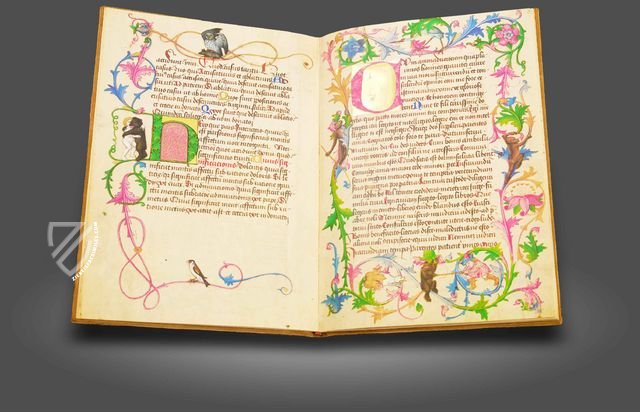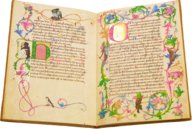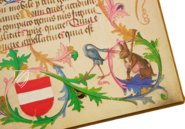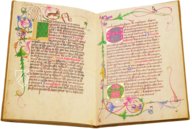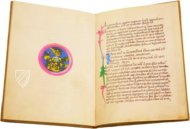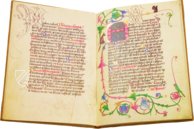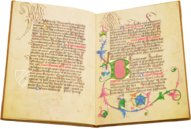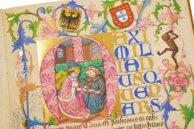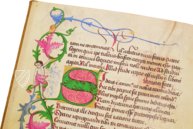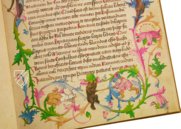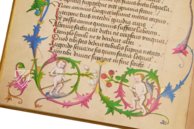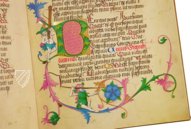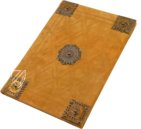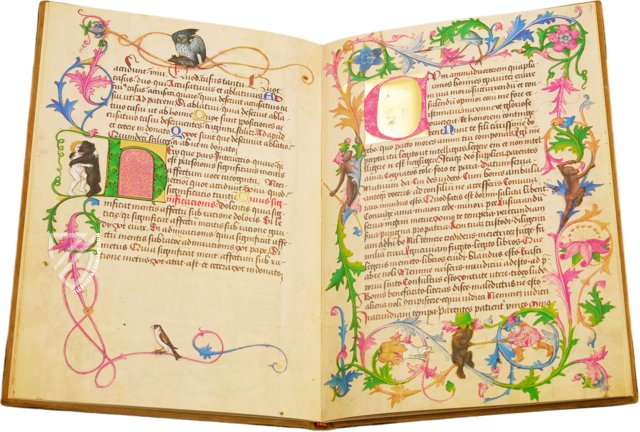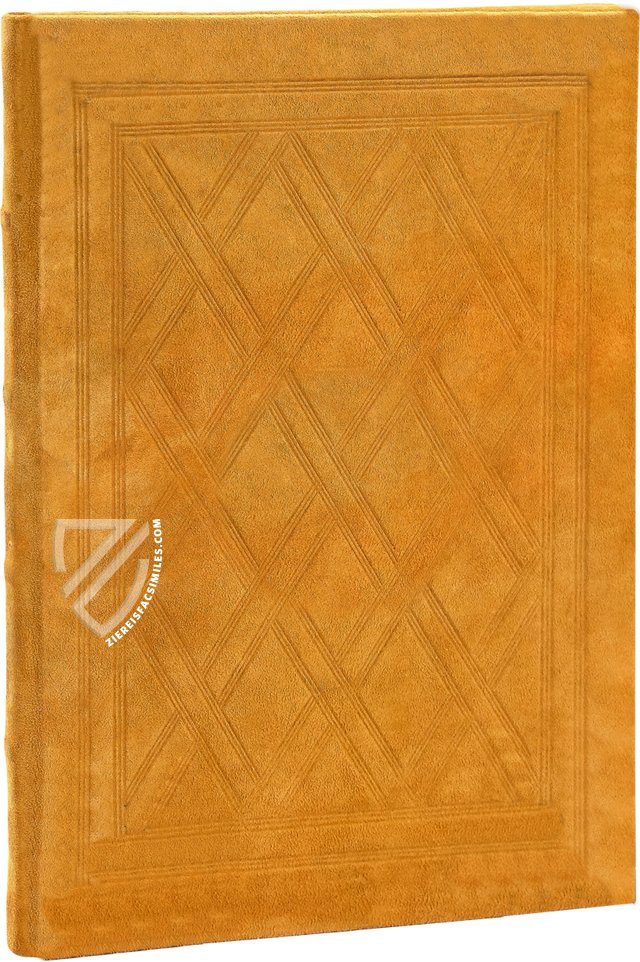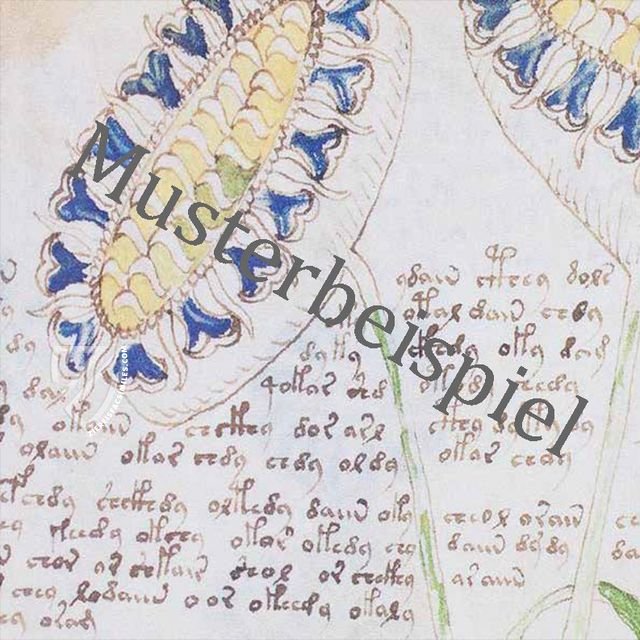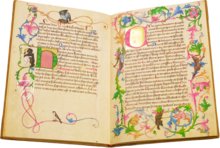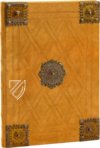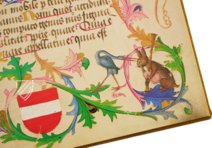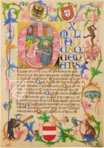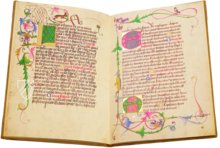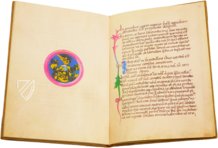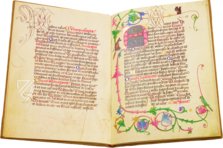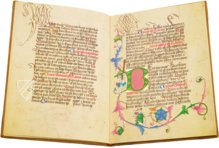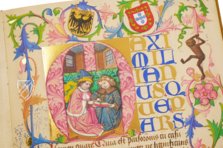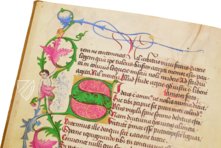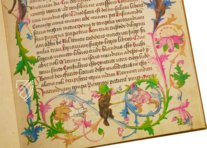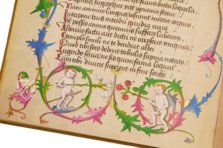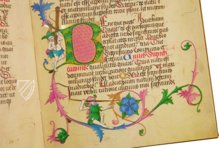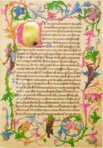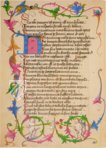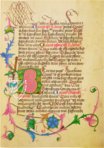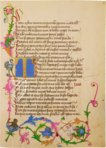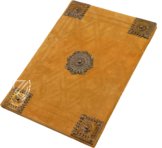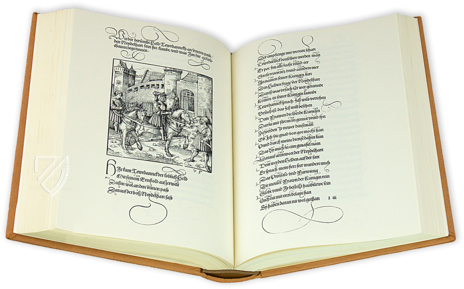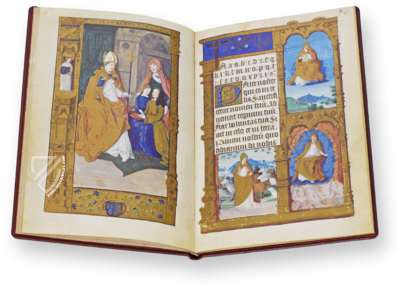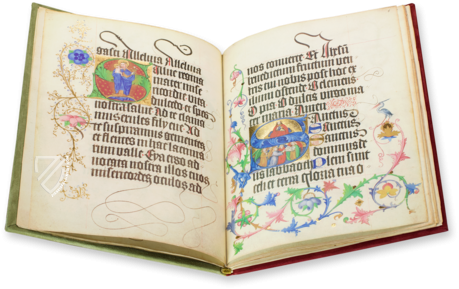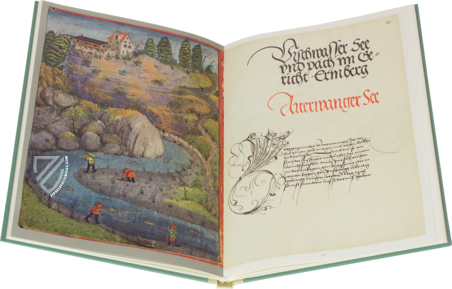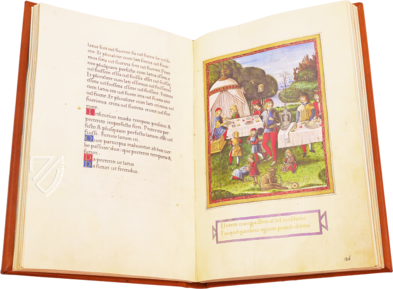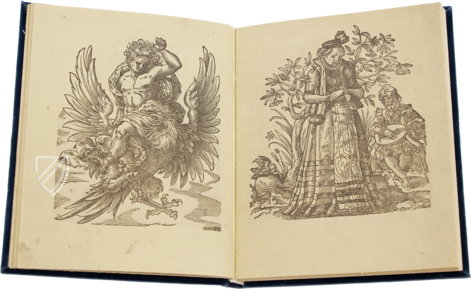A Textbook for Emperor Maximilian I.
(1,000€ - 3,000€)
With this codex, with which an emperor learned to read and write, world history seems more accessible than ever: Maximilian I (1459-1519) led the Habsburgs to the most powerful dynasty in Europe and went down in history as the "last knight" and father of the Landsknechte. But even the most powerful man in Europe first had to learn to read and write. Thus, the viewer of this magnificently decorated manuscript can look over the shoulder of the seven-year-old as he first learned the alphabet and the basic prayers. In the historiated "M" initial, little Maximilian is seen eagerly trying to decipher the first letters with his finger, together with his teacher Jakob von Fladnitz. This and 12 other ornamental initials were intended to motivate the young ruler and, together with the borders decorated with animals and mixed creatures, also give great pleasure to today's viewer.
A magnificent textbook for the "last knight"
With this textbook the emperor learned to read and write, therefore this "Textbook for Emperor Maximilian I." has an enormous cultural-historical importance. The owner of the work was the extremely talented prince who went down in history as the "last knight and first lansquenet" and under whom the Habsburgs became the most powerful ruling dynasty in Europe.
The manuscript preserved in the Austrian National Library, the so-called Tafel, is the first textbook that Maximilian was given as a seven-year-old and from which he learned the alphabet, the Pater noster, the Ave Maria and other prayers as well as mnemonic devices. In the colored miniature, executed with elaborate gold, the emperor's son himself appears: In the historiated initial on the first page we see him next to his first teacher Jakob von Fladnitz, reading from a codex. Another clue to the user is given on the first page of text by the two coats of arms of Maximilian's parents, Emperor Frederick III and Eleonora of Portugal.
The fascinating content
Following the medieval canon for first lessons, Maximilian's plate contains the basic prayers such as Pater noster, Ave Maria, Credo, Magnificat, Song of Simeon, Salve Regina, Sanctus, Requiem, Ostende nobis, and Prayer of Steps, Confiteor, Table Prayers, and finally Prayers for the Benefactor. This is followed by the Cisioianus, a verse calendar composed of short syllables that served as a memorial aid to memorize feast days and saints' days and their position in the course of the year.
A Viennese patron
In order to guarantee his son an education that befitted his nobility, Emperor Frederick III endeavored to procure valuable textbooks, but the court, in its thriftiness, did not want to pay for them itself. Finally, a benefactor was found in the wealthy Viennese citizen Stephan Heuner, who had two more textbooks made for Maximilian in addition to this manuscript. The miniatures the decor should enjoy the child and arouse his interest, so that he would remember it later.
Rich decoration, worthy of a Habsburg
12 colored, elaborately designed initial letters, as well as a genre scene inscribed in an initial, stand at the beginning of each text section. The exquisite effect of these small works of art is enhanced by precious parts of polished gold leaf adorned with chasing and hallmarks, with which the bodies of the letters are backed. The initial letters also form the starting point for delicate leafy tendrils that spread out over the parchment rim and flow into multiple leaf and flower forms. Within this floral framework numerous animals and mixed creatures cavort. While with Wolfgang Spitzweg, an imperial chancellor, the author of the textbook is known, its illuminator has remained anonymous. According to a total of three textbooks, which he decorated for Maximilian's lessons, he is called "Textbook Master".
Codicology
- Alternative Titles
- Lehrbuch für Kaiser Maximilians I.
Ars grammatica - Size / Format
- 44 pages / 30.6 × 21.7 cm
- Origin
- Austria
- Date
- Around 1465/66
- Epochs
- Style
- Script
- Gothic Humanist
- Illustrations
- Splendid opening page with Maximilian and his teacher, vine frame with animal drolleries, 13 more initials and vine frame with drolleries
- Content
- Grammatica by Aelius Donatus (fol. 2r-7v), Disticha Catonis with prose preface (fol. 8r-14v), health rules (fol. 14v-15r), coat of arms of Stephan Heuner (fol. 15v), exhortations to the future emperor by Stephan Heuner (?) (fol. 16r-20v)
- Patron
- Stephan Heuner
- Artist / School
- Master of the textbook for Emperor Maximilian I (illuminator)
- Previous Owners
- Maximilian I, later Holy Roman Emperor
Ferdinand II, Archduke of Austria
Kunsthistorisches Museum, Vienna
A Textbook for Emperor Maximilian I
The Trumscheit player
The decoration of the pages of the textbook is exceptional with the finely decorated initials and the floral borders. The "B" initial of fine acanthus leaves is framed by embossed gold leaf and backed by a pink diamond pattern. To the left of the ornamental initial, which transitions vegetally into the tendrils, is a fabulous human figure. The figure is wrapped in a leafy skirt, which takes up the floral decor. In its hands it holds a Trumscheit or trumpet fiddle, a long medieval stringed instrument covered with one gut string.
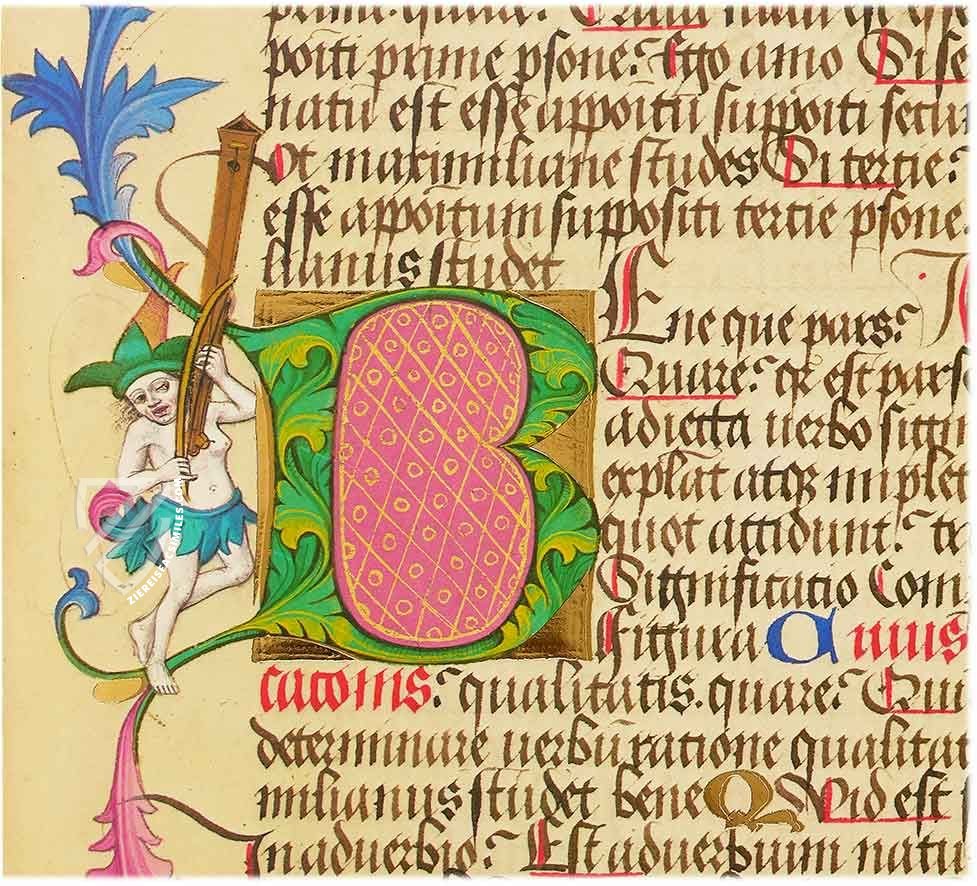
A Textbook for Emperor Maximilian I.
Maximilian at the teaching
This first page of the textbook is framed with beautiful floral tendrils of green, blue, pink and gold. Embedded in the tendrils are the escutcheons of Emperor Maximilian I (1459-1519): At the top on the left is the double-headed imperial eagle on a gold background, and to the right is the emblem of his mother, Eleonore Helena of Portugal, with castles, shields, and fleurs-de-lis. In the center of the lower tendril is the red and white striped escutcheon of the Habsburgs. In addition, the tendrils are decorated with flowers and various animals such as a monkey and heron. The music-making duo of the bear at the bottom left and the hare at the bottom right complete the composition.
The large pink "M" initial with fine acanthus leaves in a frame of embossed gold leaf is decorated with a depiction of the prince and his teacher. The prince, who is illustrated with flowing blond curls, is clad in a magnificent blue and gold brocade robe, while his teacher next to him wears a red and white robe. Besides the historiated initial, the text page is adorned by bright letters in blue and gold.
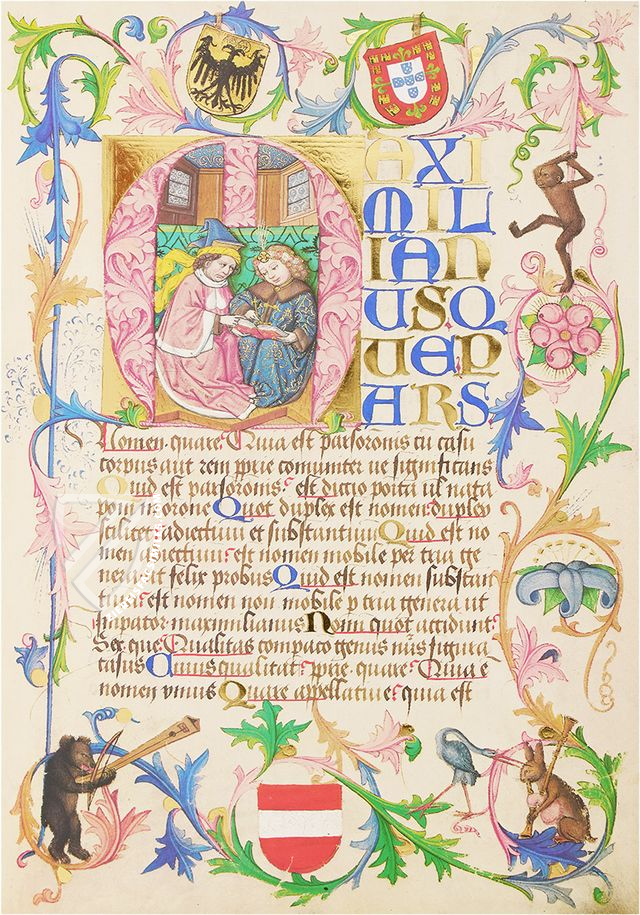
#1 Ein Lehrbuch für Kaiser Maximilian I. (Luxury Edition)
Language: German
(1,000€ - 3,000€)
#2 Lehrbuch für Kaiser Maximilian I. (Normal Edition)
Language: German
(1,000€ - 3,000€)
#3 Ein Lehrbuch für Kaiser Maximilian I. (Bibliotheksausgabe)
Language: German
- Treatises / Secular Books
- Apocalypses / Beatus
- Astronomy / Astrology
- Bestiaries
- Bibles / Gospels
- Chronicles / History / Law
- Geography / Maps
- Saints' Lives
- Islam / Oriental
- Judaism / Hebrew
- Single Leaf Collections
- Leonardo da Vinci
- Literature / Poetry
- Liturgical Manuscripts
- Medicine / Botany / Alchemy
- Music
- Mythology / Prophecies
- Psalters
- Other Religious Books
- Games / Hunting
- Private Devotion Books
- Other Genres
- Afghanistan
- Armenia
- Austria
- Belgium
- Belize
- Bosnia and Herzegovina
- China
- Colombia
- Costa Rica
- Croatia
- Cyprus
- Czech Republic
- Denmark
- Egypt
- El Salvador
- Ethiopia
- France
- Germany
- Greece
- Guatemala
- Honduras
- Hungary
- India
- Iran
- Iraq
- Israel
- Italy
- Japan
- Jordan
- Kazakhstan
- Kyrgyzstan
- Lebanon
- Liechtenstein
- Luxembourg
- Mexico
- Morocco
- Netherlands
- Palestine
- Panama
- Peru
- Poland
- Portugal
- Romania
- Russia
- Serbia
- Spain
- Sri Lanka
- Sweden
- Switzerland
- Syria
- Tajikistan
- Turkey
- Turkmenistan
- Ukraine
- United Kingdom
- United States
- Uzbekistan
- Vatican City
- A. Oosthoek, van Holkema & Warendorf
- Aboca Museum
- Ajuntament de Valencia
- Akademie Verlag
- Akademische Druck- u. Verlagsanstalt (ADEVA)
- Aldo Ausilio Editore - Bottega d’Erasmo
- Alecto Historical Editions
- Alkuin Verlag
- Almqvist & Wiksell
- Amilcare Pizzi
- Andreas & Andreas Verlagsbuchhandlung
- Archa 90
- Archiv Verlag
- Archivi Edizioni
- Arnold Verlag
- ARS
- Ars Magna
- ArtCodex
- AyN Ediciones
- Azimuth Editions
- Badenia Verlag
- Bärenreiter-Verlag
- Belser Verlag
- Belser Verlag / WK Wertkontor
- Benziger Verlag
- Bernardinum Wydawnictwo
- BiblioGemma
- Biblioteca Apostolica Vaticana (Vaticanstadt, Vaticanstadt)
- Bibliotheca Palatina Faksimile Verlag
- Bibliotheca Rara
- Boydell & Brewer
- Bramante Edizioni
- Bredius Genootschap
- Brepols Publishers
- British Library
- C. Weckesser
- Caixa Catalunya
- Canesi
- CAPSA, Ars Scriptoria
- Caratzas Brothers, Publishers
- Carus Verlag
- Casamassima Libri
- Centrum Cartographie Verlag GmbH
- Chavane Verlag
- Christian Brandstätter Verlag
- Circulo Cientifico
- Club Bibliófilo Versol
- Club du Livre
- CM Editores
- Collegium Graphicum
- Collezione Apocrifa Da Vinci
- Comissão Nacional para as Comemorações dos Descobrimentos Portugueses
- Coron Verlag
- Corvina
- CTHS
- D. S. Brewer
- Damon
- De Agostini/UTET
- De Nederlandsche Boekhandel
- De Schutter
- Deuschle & Stemmle
- Deutscher Verlag für Kunstwissenschaft
- DIAMM
- Droz
- E. Schreiber Graphische Kunstanstalten
- Ediciones Boreal
- Ediciones Grial
- Ediclube
- Edições Inapa
- Edilan
- Editalia
- Edition Deuschle
- Edition Georg Popp
- Edition Leipzig
- Edition Libri Illustri
- Editiones Reales Sitios S. L.
- Éditions de l'Oiseau Lyre
- Editions Medicina Rara
- Editorial Casariego
- Editorial Mintzoa
- Editrice Antenore
- Editrice Velar
- Edizioni Edison
- Egeria, S.L.
- Eikon Editores
- Electa
- Emery Walker Limited
- Enciclopèdia Catalana
- Eos-Verlag
- Ephesus Publishing
- Ernst Battenberg
- Eugrammia Press
- Extraordinary Editions
- Fackelverlag
- Facsimila Art & Edition
- Facsimile Editions Ltd.
- Facsimilia Art & Edition Ebert KG
- Faksimile Verlag
- Feuermann Verlag
- Folger Shakespeare Library
- Franco Cosimo Panini Editore
- Friedrich Wittig Verlag
- Fundación Hullera Vasco-Leonesa
- G. Braziller
- Gabriele Mazzotta Editore
- Gebr. Mann Verlag
- Gesellschaft für graphische Industrie
- Getty Research Institute
- Giovanni Domenico de Rossi
- Giunti Editore
- Graffiti
- Grafica European Center of Fine Arts
- Guido Pressler
- Guillermo Blazquez
- Gustav Kiepenheuer
- H. N. Abrams
- Harrassowitz
- Harvard University Press
- Helikon
- Hendrickson Publishers
- Henning Oppermann
- Herder Verlag
- Hes & De Graaf Publishers
- Hoepli
- Holbein-Verlag
- Houghton Library
- Hugo Schmidt Verlag
- Idion Verlag
- Il Bulino, edizioni d'arte
- ILte
- Imago
- Insel Verlag
- Insel-Verlag Anton Kippenberger
- Instituto de Estudios Altoaragoneses
- Instituto Nacional de Antropología e Historia
- Introligatornia Budnik Jerzy
- Istituto dell'Enciclopedia Italiana - Treccani
- Istituto Ellenico di Studi Bizantini e Postbizantini
- Istituto Geografico De Agostini
- Istituto Poligrafico e Zecca dello Stato
- Italarte Art Establishments
- Jan Thorbecke Verlag
- Johnson Reprint Corporation
- Josef Stocker
- Josef Stocker-Schmid
- Jugoslavija
- Karl W. Hiersemann
- Kasper Straube
- Kaydeda Ediciones
- Kindler Verlag / Coron Verlag
- Kodansha International Ltd.
- Konrad Kölbl Verlag
- Kurt Wolff Verlag
- La Liberia dello Stato
- La Linea Editrice
- La Meta Editore
- Lambert Schneider
- Landeskreditbank Baden-Württemberg
- Leo S. Olschki
- Les Incunables
- Liber Artis
- Library of Congress
- Libreria Musicale Italiana
- Lichtdruck
- Lito Immagine Editore
- Lumen Artis
- Lund Humphries
- M. Moleiro Editor
- Maison des Sciences de l'homme et de la société de Poitiers
- Manuscriptum
- Martinus Nijhoff
- Maruzen-Yushodo Co. Ltd.
- MASA
- Massada Publishers
- McGraw-Hill
- Metropolitan Museum of Art
- Militos
- Millennium Liber
- Müller & Schindler
- Nahar - Stavit
- Nahar and Steimatzky
- National Library of Wales
- Neri Pozza
- Nova Charta
- Oceanum Verlag
- Odeon
- Orbis Mediaevalis
- Orbis Pictus
- Österreichische Staatsdruckerei
- Oxford University Press
- Pageant Books
- Parzellers Buchverlag
- Patrimonio Ediciones
- Pattloch Verlag
- PIAF
- Pieper Verlag
- Plon-Nourrit et cie
- Poligrafiche Bolis
- Presses Universitaires de Strasbourg
- Prestel Verlag
- Princeton University Press
- Prisma Verlag
- Priuli & Verlucca, editori
- Pro Sport Verlag
- Propyläen Verlag
- Pytheas Books
- Quaternio Verlag Luzern
- Reales Sitios
- Recht-Verlag
- Reichert Verlag
- Reichsdruckerei
- Reprint Verlag
- Riehn & Reusch
- Roberto Vattori Editore
- Rosenkilde and Bagger
- Roxburghe Club
- Salerno Editrice
- Saltellus Press
- Sandoz
- Sarajevo Svjetlost
- Schöck ArtPrint Kft.
- Schulsinger Brothers
- Scolar Press
- Scrinium
- Scripta Maneant
- Scriptorium
- Shazar
- Siloé, arte y bibliofilia
- SISMEL - Edizioni del Galluzzo
- Sociedad Mexicana de Antropología
- Société des Bibliophiles & Iconophiles de Belgique
- Soncin Publishing
- Sorli Ediciones
- Stainer and Bell
- Studer
- Styria Verlag
- Sumptibus Pragopress
- Szegedi Tudomànyegyetem
- Taberna Libraria
- Tarshish Books
- Taschen
- Tempus Libri
- Testimonio Compañía Editorial
- Thames and Hudson
- The Clear Vue Publishing Partnership Limited
- The Facsimile Codex
- The Folio Society
- The Marquess of Normanby
- The Richard III and Yorkist History Trust
- Tip.Le.Co
- TouchArt
- TREC Publishing House
- TRI Publishing Co.
- Trident Editore
- Tuliba Collection
- Typis Regiae Officinae Polygraphicae
- Union Verlag Berlin
- Universidad de Granada
- University of California Press
- University of Chicago Press
- Urs Graf
- Vallecchi
- Van Wijnen
- VCH, Acta Humaniora
- VDI Verlag
- VEB Deutscher Verlag für Musik
- Verlag Anton Pustet / Andreas Verlag
- Verlag Bibliophile Drucke Josef Stocker
- Verlag der Münchner Drucke
- Verlag für Regionalgeschichte
- Verlag Styria
- Vicent Garcia Editores
- W. Turnowski Ltd.
- W. Turnowsky
- Waanders Printers
- Wiener Mechitharisten-Congregation (Wien, Österreich)
- Wissenschaftliche Buchgesellschaft
- Wissenschaftliche Verlagsgesellschaft
- Wydawnictwo Dolnoslaskie
- Xuntanza Editorial
- Zakład Narodowy
- Zollikofer AG

